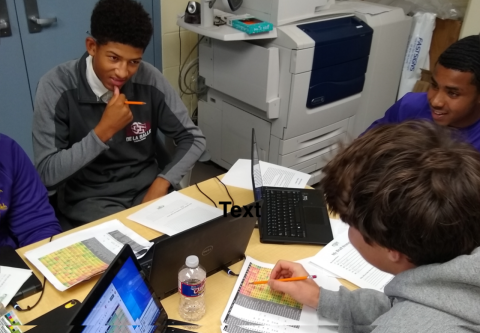Teen Baseball Players Schooled in the Art of “Moneyball” Math
At age six, Gavin Lewis Jr., caught a rare sight in New Orleans: kids playing baseball in a park. The Crescent City is known for its football, but after Lewis told his dad he wanted to try America’s favorite past-time, he “kind’ve fell in love with baseball,” he says.
Lewis, now a 16-year-old college prospect playing for De La Salle High School, recently participated in the Baseball Analytics Program at the Major League Baseball Youth Academy (MLBYA) facility in New Orleans — a collaboration between the Tulane University’s Center for Sport and the MLBYA. The middle infielder credits the class with improving his game and introducing him to another potential career path.
“After the class, I shifted my thinking about how to play, to see what [scouts] look for,” says Lewis. One example? He adjusted his swing to aim for gaps in the outfield instead of hitting for singles. “I feel like I’m already seeing better results.”
The six-lesson course — designed to attract students of color from the greater New Orleans area — gave 11 high schoolers a crash-course in advanced statistics. Think: a marriage between the complex sabermetrics featured in the Academy Award-nominated movie “Moneyball” (2011), mixed with a little bit of fantasy baseball for good measure — a spoonful of baseball to make the math go down.
“The hidden agenda was to get the math techniques in,” says Tulane math professor Michael Joyce. “And to get the students to see how math can be very useful.”
“We didn’t really know what to expect. But they were an amazingly talented group of kids.”
The class, made up of students from six local high schools, was taught by Joyce and associate science and engineering professor Scott McKinley, and facilitated by professor Gabe Feldman, director of the Tulane Sports Law program and co-founder of the Center for Sport. As part of the Center’s sports education programming, Feldman also developed and taught a sports law class for MLBYA students.
“Part of the fun of these classes is that they allow students to be creative,” Feldman says. “But creative with a broader arsenal of weapons to use to attack problems.”
Students started by plotting data about home runs versus runs scored, and they were able to parse out the difference between the two stats. Joyce said students came to appreciate more complicated metrics than just home runs, like OPS: on-base percentage and slugging.
It was a way for students of the game to recognize another layer in their favorite sport.
“We want to focus on the 90-95 percent who won’t play in college or professional,” says MLBYA New Orleans director Eddie Davis. “We hope to build a vocational program.”
Lewis says he’s eager to take the course again, which the Center for Sport and MLBYA will offer again in Spring and Fall 2020.
“I never really knew how people calculated and worked with the analytics end of baseball,” Lewis says. “But now that I know how it works, it is something I might consider pursuing if baseball doesn’t work out for me.”
—By Liam Pierce
For information about MLBYA and Center for Sport classes at Tulane and other sports education programs, contact Director of Education, Teresa Belt (tbelt@tulane.edu).
About the Center for Sport at Tulane University
The positive impact of sport reaches far beyond the field of play. We believe sport has the power to improve the human condition. The Center for Sport is devoted to studying, supporting and achieving in all areas where sport engages people — on the field of play, in human health and professional careers, and in our community. For more information about the Center for Sport, visit centerforsport.tulane.edu.

